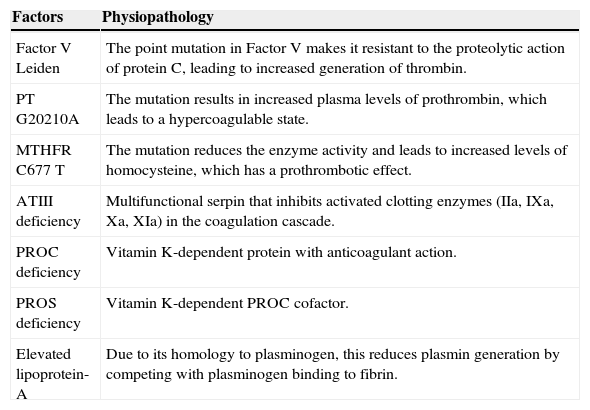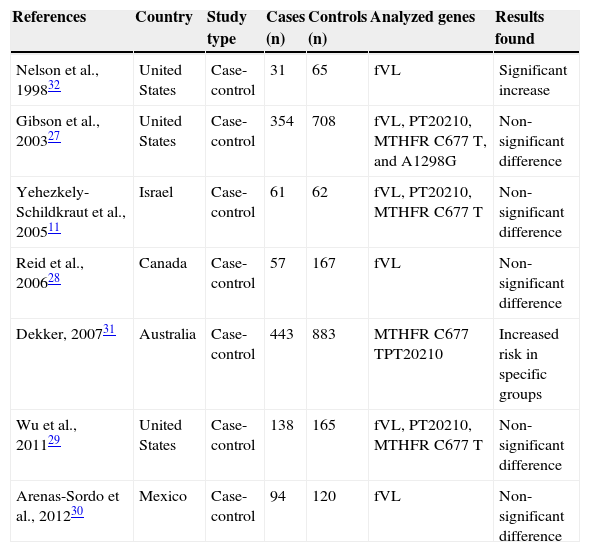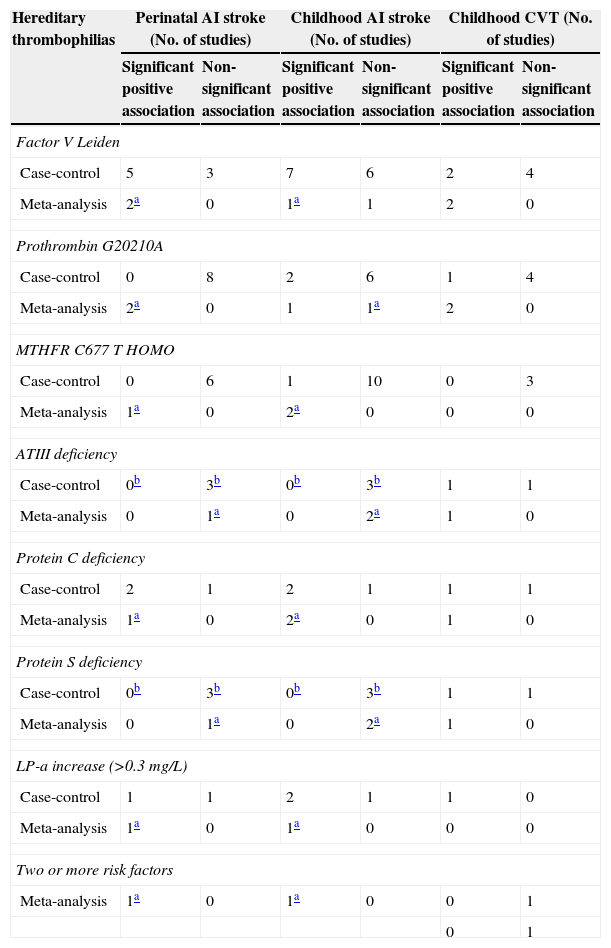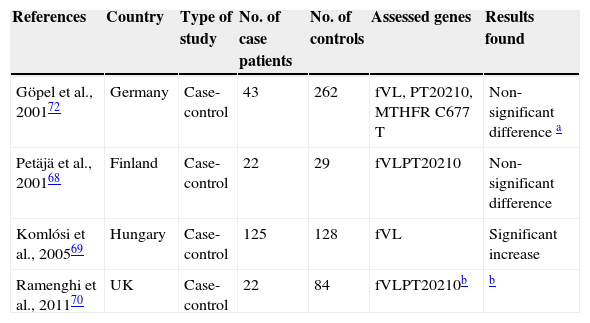This review aimed to organize and consolidate the latest knowledge about mutations and genetic polymorphisms related to hereditary thrombophilia and their potential association with pediatric stroke and cerebral palsy (CP).
SourcesScientific articles published from 1993 to 2013, written in Portuguese, English, French, and Spanish, were selected and reviewed. The publications were searched in electronic databases, and also in the collections of local libraries. The terms “hereditary thrombophilia”, “polymorphisms”, “mutation”, “pediatric strokes”, and “cerebral palsy” were used for the research.
Summary of the findingsThe search in databases and in the bibliographic references retrieved 75 articles for inclusion in this review. Studies that investigated hereditary thrombophilias and their associations to CP and arterial and venous pediatric stroke presented contradictory results. The meta-analysis and case-control studies that showed positive results for this association described only slightly increased relative risks and sometimes had questionable conclusions. The association of two or more hereditary thrombophilias, or the association between thrombophilia and other specific clinical risk factors, suggest a higher risk of CP and pediatric stroke than isolated hereditary thrombophilia.
ConclusionsLarger, multicenter studies should be developed in order to elucidate the role of mutations leading to hereditary thrombophilia and the development of CP and pediatric stroke. The complex and multifactorial etiology of CP and stroke makes this an arduous and difficult task; however, the benefits generated by these studies are immeasurable.
Sistematizar e integrar os últimos conhecimentos sobre mutações e polimorfismos genéticos relacionados às trombofilias hereditárias e suas potenciais associações com acidentes vasculares cerebrais pediátricos (AVC) e paralisia cerebral (PC).
Fontes de DadosArtigos científicos publicados de 1993 a 2013, escritos em português, inglês, francês e espanhol foram selecionados e revisados. As publicações foram pesquisadas nas bases de dados eletrônicas, como também nos acervos das bibliotecas locais. Os termos mutação, polimorfismos, trombofilias hereditárias, acidentes vasculares cerebrais pediátricos e paralisia cerebral foram utilizados para a pesquisa.
Síntese dos DadosA pesquisa nas bases de dados e nas referências bibliográficas identificou 75 artigos para inclusão nesta revisão. Os estudos que investigaram as trombofilias hereditárias e suas associações à PC e aos AVC pediátricos arteriais e venosos apresentaram resultados contraditórios. As metanálises e os estudos caso-controle que demonstraram resultados positivos para esta associação, descreveram riscos relativos discretamente aumentados e, algumas vezes, questionáveis. A associação de duas ou mais trombofilias hereditárias, ou a junção de trombofilias específicas com demais fatores de riscos clínicos, sugerem maior risco no aparecimento da PC e do AVC pediátrico do que as trombofilias hereditárias isoladas.
ConclusõesEstudos multicêntricos de grande porte devem ser conduzidos para elucidar o papel real das mutações que levam às trombofilias hereditárias e ao aparecimento da PC e AVC pediátricos. A etiologia multifatorial e complexa da PC e dos AVC torna esta tarefa árdua e difícil, porém, os benefícios gerados por estes estudos são incalculáveis.
Mutations in genes associated with the coagulation cascade trigger hypercoagulable states (hereditary thrombophilia) that, in theory, increase the risk of stroke and cerebral palsy (CP). In children, the incidence of different types of stroke varies from 0.67 to 23 per 100,000 live births and the evolution of these lesions to CP is quite significant (Table 1).1–7 CP is the most common motor manifestation of childhood and its prevalence in Brazil is estimated at about 30,000 to 40,000 new cases per year.8,9
Association between stroke and CP.
| Type of stroke | Incidence | Evolution to cerebral palsy |
|---|---|---|
| Perinatal arterial ischemicChildhood arterial ischemic stroke | 17 to 23 per 100,000 live births1,217-fold less than perinatal AI1,2 | 68% to 78% (87.6% hemiplegic and 12.4% tetraplegic)5,6 |
| Central venous thrombosis | 0.67 for every 100,000 children3 | 67%7 |
| Perinatal hemorrhagicChildhood hemorrhagic | 2-3 per 100,000 children4 | Sequelae in 42% of cases, among them CP4 |
The main mutations associated with prothrombotic states are described in factor V Leiden, prothrombin G20210A in methylenetetrahydrofolate reductase (MTHFR; C677T and A1298C), in protein C, in protein S, in antithrombin and lipoprotein-A.10 The presumed physiopathology for these mutations is described in Table 2.10–12
Presumed physiopathology of mutations in genes related to coagulation cascade clotting factors in prothrombotic states.
| Factors | Physiopathology |
|---|---|
| Factor V Leiden | The point mutation in Factor V makes it resistant to the proteolytic action of protein C, leading to increased generation of thrombin. |
| PT G20210A | The mutation results in increased plasma levels of prothrombin, which leads to a hypercoagulable state. |
| MTHFR C677T | The mutation reduces the enzyme activity and leads to increased levels of homocysteine, which has a prothrombotic effect. |
| ATIII deficiency | Multifunctional serpin that inhibits activated clotting enzymes (IIa, IXa, Xa, XIa) in the coagulation cascade. |
| PROC deficiency | Vitamin K-dependent protein with anticoagulant action. |
| PROS deficiency | Vitamin K-dependent PROC cofactor. |
| Elevated lipoprotein-A | Due to its homology to plasminogen, this reduces plasmin generation by competing with plasminogen binding to fibrin. |
Source: Zadro & Herak, 201210. Adapted.
The aim of this study was to systematically review and consolidate the studies that evaluated the mutations and polymorphisms in genes associated with hereditary thrombophilias and their possible associations with pediatric stroke and cerebral palsy.
MethodsThe study consisted of a systematic review of the main publications that described mutations related to hereditary thrombophilias and their potential associations with pediatric stroke and cerebral palsy.
Publication dates were 1993-2013 and languages accepted for reading were Portuguese, English, French, and Spanish. Research on the subject was conducted in electronic databases (Medline, PubMed, SciELO, OVID, Web of Science, Elsevier ScienceDirect, and CAPES Journals) and in the collections of the libraries of the Pontifícia Universidade Católica de Goiás and Universidade Federal de Goiás. The terms hereditary thrombophilia, mutations, polymorphisms, pediatric stroke, and cerebral palsy were used for the research. The methodology used was described by Green.13
Publications such as meta-analyses, case-control studies, case series, and descriptions of clinical cases were included. The research in the databases identified 1,731 potential articles for inclusion in the review. After reading the abstracts 67 articles were selected for full reading, of which seven were excluded for not meeting the criteria for the diagnosis of CP or due to duplicity. The search of the references from the studies that were read in full resulted in the inclusion of 15 new articles.
Pediatric stroke can be divided into arterial, ischemic and hemorrhagic, and venous stroke. These are also classified into perinatal, when they occur during pregnancy up to 28 days of life, and childhood stroke.1,2,14 According to the 2006 International Workshop on Definition and Classification of Cerebral Palsy of Maryland, the term cerebral palsy (CP) describes a group of permanent disorders in the development of movement and posture, causing activity limitation, attributed to nonprogressive disorders that occurred in the developing fetal or infant brain. The motor disorders of cerebral palsy are often accompanied by sensory, perception, cognition, communication, and behavior disorders, as well as epilepsy and secondary musculoskeletal problems.15–17
ResultsThe literature review selected articles that investigated potential associations between hereditary thrombophilia and CP or between hereditary thrombophilia and pediatric stroke, including arterial ischemic (AI) stroke, hemorrhagic stroke, and cerebral venous thrombosis (CVT). The research resulted in different types of studies; however, the case-control studies and meta-analyses were favored, as they have the greatest impact on the area knowledge, while the clinical case studies and case series were only briefly mentioned.
The literature review of studies investigating the association between hereditary thrombophilia and CP resulted in five case reports,18–23 four series studies,14,24–26 and seven case-control studies. The results of the case-control studies are summarized in Table 3. Of the studies that aimed to describe an association between hereditary thrombophilia and CP, most failed to determine an association.11,27–30
Studies that assessed direct associations between CP and hereditary thrombophilias (author, year, country, type of study and analyzed genes).
| References | Country | Study type | Cases (n) | Controls (n) | Analyzed genes | Results found |
|---|---|---|---|---|---|---|
| Nelson et al., 199832 | United States | Case-control | 31 | 65 | fVL | Significant increase |
| Gibson et al., 200327 | United States | Case-control | 354 | 708 | fVL, PT20210, MTHFR C677T, and A1298G | Non-significant difference |
| Yehezkely-Schildkraut et al., 200511 | Israel | Case-control | 61 | 62 | fVL, PT20210, MTHFR C677T | Non-significant difference |
| Reid et al., 200628 | Canada | Case-control | 57 | 167 | fVL | Non-significant difference |
| Dekker, 200731 | Australia | Case-control | 443 | 883 | MTHFR C677TPT20210 | Increased risk in specific groups |
| Wu et al., 201129 | United States | Case-control | 138 | 165 | fVL, PT20210, MTHFR C677T | Non-significant difference |
| Arenas-Sordo et al., 201230 | Mexico | Case-control | 94 | 120 | fVL | Non-significant difference |
Only two studies have been able to establish some degree of association, especially the study by Dekker,31 which showed a higher risk of CP in preterm infants with the MTHFR C677T mutation in homozygous state, and in patients who accumulate both MTHFR C677T polymorphisms in homozygous state and PT G20210A polymorphisms, in heterozygous state. The study by Nelson et al.32 was the only one that showed a significant association between an isolated hereditary thrombophilia (fVL) and CP, without sample stratification.
The literature review on the association between hereditary thrombophilias and perinatal AI stroke resulted in one case report,33 eight case-control studies, and two meta-analyses. The studies on the association between hereditary thrombophilias and childhood AI stroke, obtained from the databases, totaled 16 case-control studies and two meta-analyses. The case-control studies published during the study period showed discordant results on the higher frequency of hereditary thrombophilia in patients with perinatal AI stroke (Table 4).34–42
Integration of results of case-control studies and meta-analyses on possible associations between hereditary thrombophilias and perinatal AI stroke, childhood AI stroke and childhood CVT.
| Hereditary thrombophilias | Perinatal AI stroke (No. of studies) | Childhood AI stroke (No. of studies) | Childhood CVT (No. of studies) | |||
|---|---|---|---|---|---|---|
| Significant positive association | Non-significant association | Significant positive association | Non-significant association | Significant positive association | Non-significant association | |
| Factor V Leiden | ||||||
| Case-control | 5 | 3 | 7 | 6 | 2 | 4 |
| Meta-analysis | 2a | 0 | 1a | 1 | 2 | 0 |
| Prothrombin G20210A | ||||||
| Case-control | 0 | 8 | 2 | 6 | 1 | 4 |
| Meta-analysis | 2a | 0 | 1 | 1a | 2 | 0 |
| MTHFR C677T HOMO | ||||||
| Case-control | 0 | 6 | 1 | 10 | 0 | 3 |
| Meta-analysis | 1a | 0 | 2a | 0 | 0 | 0 |
| ATIII deficiency | ||||||
| Case-control | 0b | 3b | 0b | 3b | 1 | 1 |
| Meta-analysis | 0 | 1a | 0 | 2a | 1 | 0 |
| Protein C deficiency | ||||||
| Case-control | 2 | 1 | 2 | 1 | 1 | 1 |
| Meta-analysis | 1a | 0 | 2a | 0 | 1 | 0 |
| Protein S deficiency | ||||||
| Case-control | 0b | 3b | 0b | 3b | 1 | 1 |
| Meta-analysis | 0 | 1a | 0 | 2a | 1 | 0 |
| LP-a increase (>0.3mg/L) | ||||||
| Case-control | 1 | 1 | 2 | 1 | 1 | 0 |
| Meta-analysis | 1a | 0 | 1a | 0 | 0 | 0 |
| Two or more risk factors | ||||||
| Meta-analysis | 1a | 0 | 1a | 0 | 0 | 1 |
| 0 | 1 | |||||
The meta-analyses assessed together the relative risk of hereditary thrombophilia for patients with perinatal and childhood AI stroke. Renaud et al.43 found a greater prevalence of FVL mutation and PT G20210 mutation in these patients, when compared to controls.
Kenet et al.12 reported higher frequencies for FVL (OR: 3.70; 95% CI: 2.82 to 4.85) for the PT G20210A mutation (OR: 2.60;95% CI: 1.66 to 4.08) for the MTHFR C677T mutation in homozygous state (OR: 1.58; 95% CI: 1.20 to 2.08), for PROC deficiency (OR: 11.0; 95% CI: 5.13 -23.59) and for elevated lipoprotein A (OR: 6.53; 95% CI: 4.46 to 9.55) in the group of patients when compared to controls. The association of two or more hereditary thrombophilias was also 18.75-fold higher (95% CI: 6.49 to 54.14) in the assessed patients. This meta-analysis found no increase in the relative risk for antithrombin deficiency (OR: 3.29; 95% CI: 0.70 to 15.48) and S protein deficiency (OR 1.49; 95% CI: 0.32 to 6.92).
Sixteen case-control studies investigated the associations between hereditary thrombophilia and childhood AI stroke. The results of these studies were divergent and are shown in Table 4.44–61 The literature survey also retrieved two meta-analyses that evaluated the probable associations between mutations in genes linked to hereditary thrombophilia and childhood stroke.12,62 Haywood et al.62 evaluated case-control studies published between 1989 and 2000 and demonstrated a higher frequency of PROC deficiency (OR: 11.0; 95% CI: 5.1 to 23.6) and the MTHFR C677T mutation (OR: 1.70; 95% CI: 1.23 to 2.34) in patients with childhood AI stroke. The authors did not observe increased frequencies for FVL (OR: 1.2; 95% CI: 0.8-1.9), for the PT G20210A mutation (OR: 1.1; 95% CI: 0.5- 2.3), for antithrombin deficiency (OR: 1.0; 95% CI: 0.3 to 3.7), and for PROS deficiency (OR: 1.1; 95% CI: 0.3-3.8) in cases when compared to controls.
The literature review on the association between hereditary thrombophilias and pediatric CVT retrieved one case report63 and one case series.64 The literature search also retrieved six case-control studies,38,41,53,65–67 which showed conflicting results on the influence of hereditary thrombophilia on CVT (Table 4).
The meta-analyses indicated that, in patients with CVT, there was a greater frequency for FVL mutation (2.7-3.1 times), PT G20210A mutation (1.9-3.1 times), protein C deficiency (6.3 times), protein S deficiency (5.3 times), and ATIII deficiency (18.4 times), as well as elevated lipoprotein-A levels (7.2 times). However, these findings were not observed for the MTHFR C677T mutation in homozygous state.12,41
Four case-control studies60,68–70 and a series study71 that correlated hereditary thrombophilias with hemorrhagic stroke were selected for the present review. All studies referred to germinal matrix-intraventricular hemorrhage (GM-IVH) in the neonatal period. Condensed data from these studies are presented in Table 5. Two case-control studies selected in this review showed no increased relative risk for FVL, PT G20210A, and MTHFR C677T mutations in patients with GM-IVH, when compared to controls.68,72
Studies that analyzed possible associations between hemorrhagic stroke and hereditary thrombophilias.
| References | Country | Type of study | No. of case patients | No. of controls | Assessed genes | Results found |
|---|---|---|---|---|---|---|
| Göpel et al., 200172 | Germany | Case-control | 43 | 262 | fVL, PT20210, MTHFR C677T | Non-significant difference a |
| Petäjä et al., 200168 | Finland | Case-control | 22 | 29 | fVLPT20210 | Non-significant difference |
| Komlósi et al., 200569 | Hungary | Case-control | 125 | 128 | fVL | Significant increase |
| Ramenghi et al., 201170 | UK | Case-control | 22 | 84 | fVLPT20210b | b |
Göpel et al.72 observed that FVL and PT G20210A mutations conferred a negative relative risk for more severe forms of GM-IVH, suggesting a protective effect against the worsening of bleeding caused by these mutations. One possible explanation is the faster coagulation due to thrombophilia.
Komlósi et al.69 demonstrated a higher frequency of FVL in premature patients with GM-IVH when compared to controls; however, these results were not confirmed for patients born at term. Ramenghi et al.70 observed a higher frequency for the combination of FVL and prothrombin G20210A mutation in patients with GM-IVH when compared to controls. The grouping of different thrombophilias hinders conclusions on the physiological role of each individual type and is usually assessed in very small samples.
DiscussionOf the studies that aimed to describe a direct correlation between hereditary thrombophilias and CP, most failed to establish this association,11,27–32 suggesting a secondary effect of thrombophilia on the onset of CP.
The results obtained for AI stroke are very similar for the two pediatric periods (perinatal and childhood). Individual analysis of genetic factors associated with thrombophilia shows a discrete role in the onset of pediatric arterial ischemic stroke. The combination of two or more hereditary thrombophilias with other clinical risk factors appears to be more significant in clinical practice than the study of isolated genetic factors.12 This fact prevents the diagnosis of isolated mutations from determining clinical management conclusively, as the risk/benefit of anticoagulants and other medications has yet to be established.73
The conclusions obtained on the role of hereditary thrombophilias in the etiology of pediatric AI stroke are also valid for the onset of CVT in childhood. Thrombophilias result in a small and questionable increase in the relative risk of CVT. This fact, added to the low prevalence of CVT in childhood, hinders the use of these results in medical practice.12 In this review, only studies on hereditary thrombophilia and perinatal hemorrhagic stroke (GM-IVH) were included. The small number of studies and, consequently, of assessed cases, makes it difficult to obtain conclusions about this association.68–72
Some limitations influenced this review about the possible associations between hereditary thrombophilia, cerebral palsy and stroke. The first is related to the studied patients that had several acquired factors for the onset of pediatric stroke, such as sepsis and dehydration, among others.3 Additionally, it is known that the measurement of some proteins involved in coagulation can be influenced by several diseases, such as protein S, protein C and antithrombin, which are affected by liver, kidney, and infectious diseases.74
Another important limitation derives from the fact that most studies have been performed in populations of North America and Europe. As the frequency of hereditary thrombophilia varies significantly from population to population, these studies should be replicated in different geographic regions.62 Finally, it should be noted that some studies have evaluated stroke globally, without classifying them into arterial or venous, or into perinatal or childhood stroke. This fact was observed in two of the meta-analyses that assessed the association between hereditary thrombophilia and AI stroke and that performed data analyses of the neonatal and childhood periods together, which hinders the analysis of the obtained conclusions.12,43
Conclusions and future perspectivesRegarding the potential effect of the mutations in genes associated with hereditary thrombophilia and their association with pediatric stroke and cerebral palsy, the authors conclude that small increases in the relative risk were described in the reviewed studies, suggesting a secondary role of these mutations in the onset of these manifestations. The combination of more than one mutation associated with clinical risk factors suggests a more significant role in the etiology of pediatric stroke and CP.
Multicenter studies evaluating a larger number of genes together are necessary to elucidate the actual role of the mutations associated with hereditary thrombophilias in the etiology of CP/pediatric stroke.
The multifactorial and complex etiology of CP makes this a difficult and arduous task, but the benefits generated by these studies are invaluable.
Conflicts of interestThe authors declare no conflicts of interest.
Please cite this article as: Torres VM, Saddi VA. Systematic review: hereditary thrombophilia associated to pediatric strokes and cerebral palsy. J Pediatr (Rio J). 2015;91:22–9.













